Tom's Hardware Verdict
The MSI B450 Gaming Pro Carbon AC misses the mark on value. But it looks better than the competition, provides cooler Vreg operation, and might be worth paying extra for those things are important to you.
Pros
- +
Excellent Vreg cooling for B450
- +
Enjoyable UEFI experience
- +
Good layout
- +
Top-shelf experience without the X470 tax
Cons
- -
Disappointing memory overclocks
- -
Confusing PCIe and M.2 wiring
- -
A bit pricier than the competition
Why you can trust Tom's Hardware
Product Description and UEFI
With tax season in the US in full swing, some of us are looking forward to dropping some of our refund on upgrades to outfit our rigs with the latest and greatest in the PC hardware scene. With RTX, Radeon VII, and 3000 series processors on the horizon, it is easy to look past the motherboard when picking components. MSI hopes to change all that with an inexpensive ($140 US) overclocking board that's tough to pass up, thanks to its overclock-encouraging oversized heat sinks and elaborate onboard RGB lighting.
Specifications
| Socket | AM4 |
| Chipset | AMD B450 |
| Form Factor | ATX |
| Voltage Regulator | 8*+2 Phases (*Doubled) |
| Video Ports | DisplayPort 1.2, HDMI 1.4 |
| USB Ports | 10 Gbps: (1) Type-C, (1) Type A5Gb/s: (2) Type AUSB 2.0: (2) Type A |
| Network Jacks | (1) Gigabit Ethernet, (2) SMA Antenna |
| Audio Jacks | (5) Analog, (1) Digital |
| Legacy Ports/Jacks | (1) PS/2 |
| Other Ports/Jack | BIOS Flashback |
| PCIe x16 | (1) v3.0 x16, (1) v2.0 x4 |
| PCIe x8 | ✗ |
| PCIe x4 | ✗ |
| PCIe x1 | (3*) v2.0 |
| CrossFire/SLI | 2x / ✗ |
| DIMM slots | (4) DDR4 |
| M.2 slots | (1) PCIe v3 x4 / SATA3 42/60/80/110mm(1) PCIe v2 x4 / SATA3 42/60/80mm |
| U.2 Ports | ✗ |
| SATA Ports | (6*) 6Gb/s |
| USB Headers | (1) 5Gb/s, (2) v2.0 |
| Fan Headers | (6) 4-Pin |
| Legacy Interfaces | Serial COM Port |
| Other Interfaces | (1) TPM, (2) RGB, (1) Addressable LED, (1) CORSAIR Connector, (1) Front Panel Audio |
| Diagnostics Panel | LED |
| Internal Button/Switch | ✗ / ✗ |
| SATA Controllers | Integrated (0/1/10) |
| Ethernet Controllers | (1) Intel® I211AT |
| Wi-Fi / Bluetooth | Intel® 802.11ac 9260 WiFi Module, Bluetooth 4.2 / 3.0 |
| USB Controllers | ✗ |
| HD Audio Codec | Realtek ALC1220 |
| DDL/DTS Connect | ✗ / ✗ |
| Warranty | 3 Years |
Features
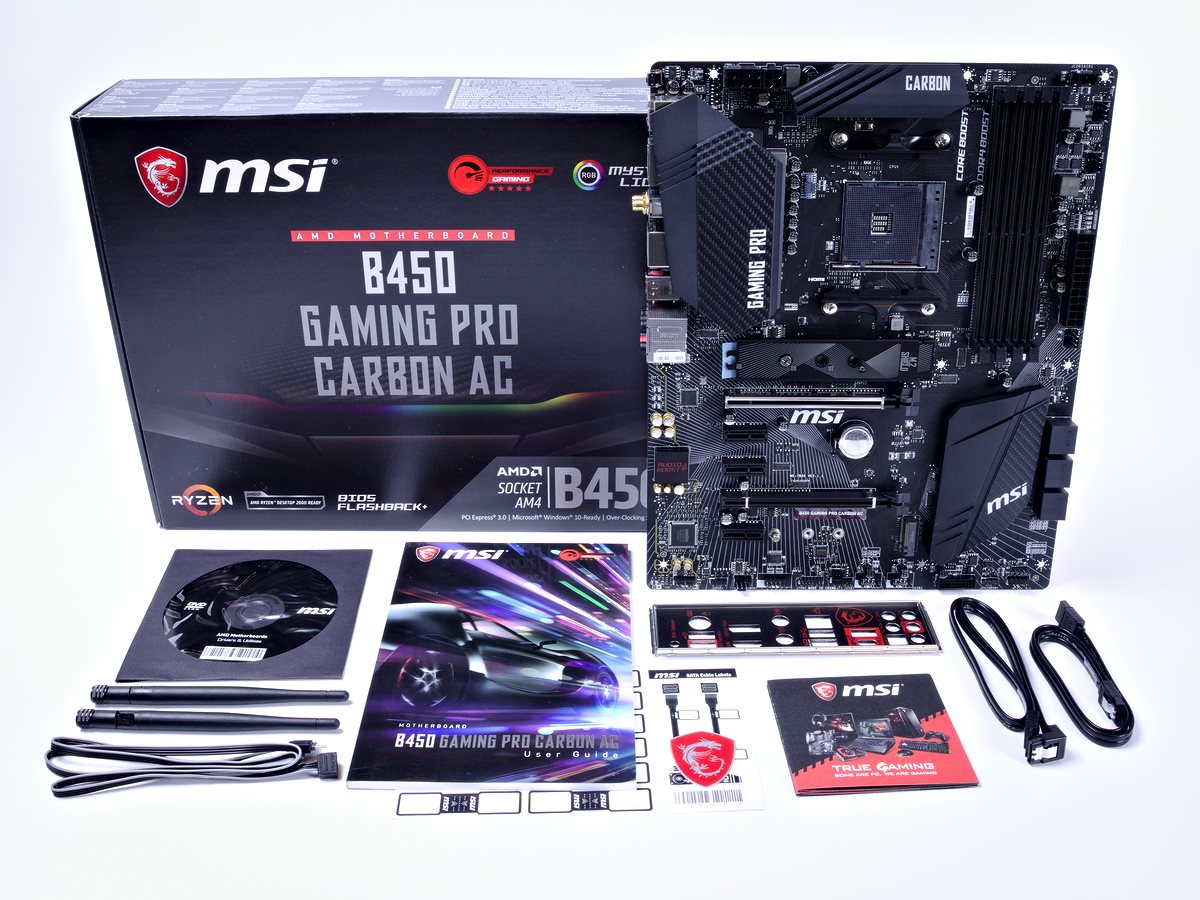
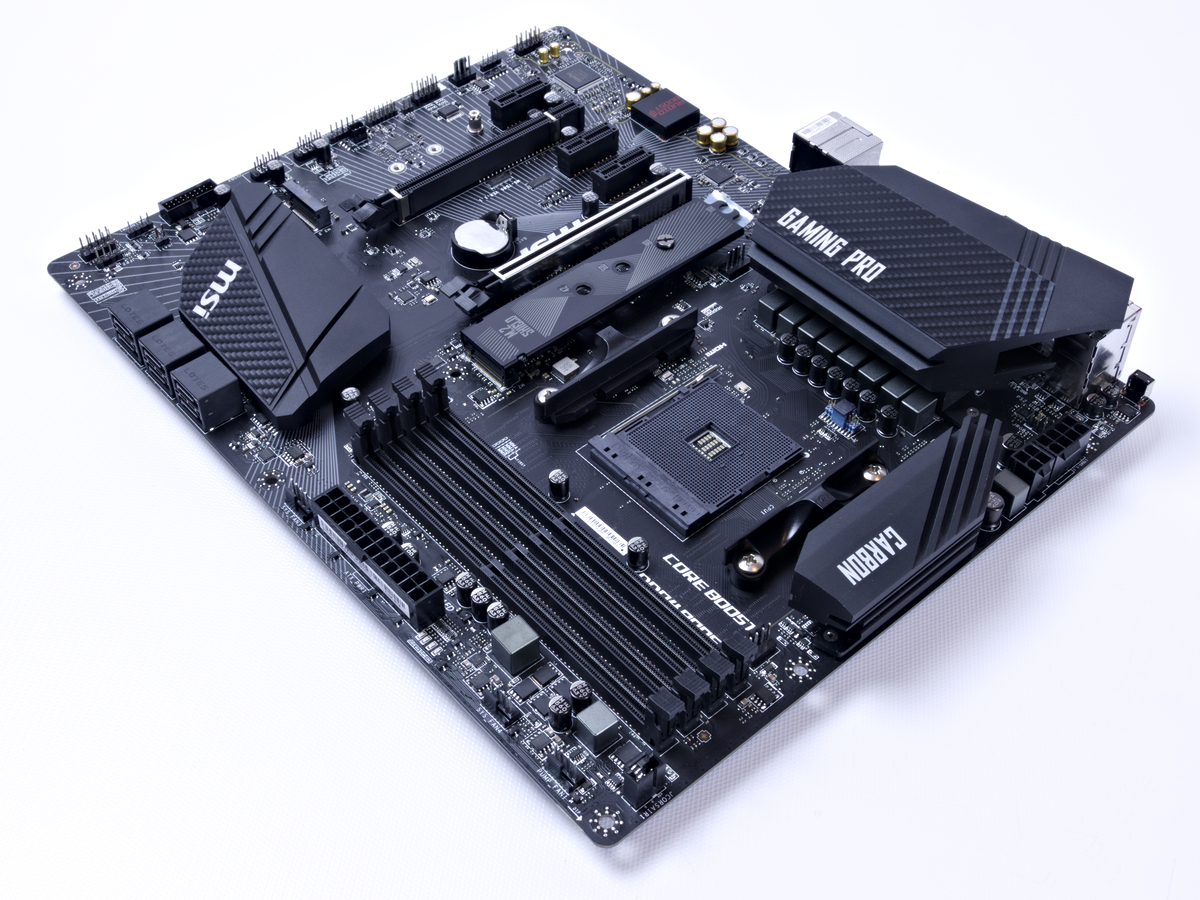
MSI’s lineup is aiming for the higher-tiered buyers out there by streamlining their portfolio’s aesthetic from the Kraits of old to the newer MEG, MAG, and Gaming brands. While browsing our favorite online retailers, it’s easy to get confused as to which MSI “Gaming” motherboard to pick up and identify the shift of quality versus feature sets. But residing at the top end of the B450 board stack, the MSI B450 Gaming Pro Carbon AC bundles in a lot of features that the X470 Pro Carbon AC provides, for about $50 less.
The product packaging presents a more toned-down aesthetic similar to a high-octane performance car rather than other B450 offerings on the market. Contents of the box are slim compared to our X470 “top-tier” expectations, but for a B450 board, they cover all the bases with a padded backplate, pair of SATA cables, direct-attach Wi-Fi antenna, LED extension cable, case badge, driver disk, various documentation, and adhesive cable labels.
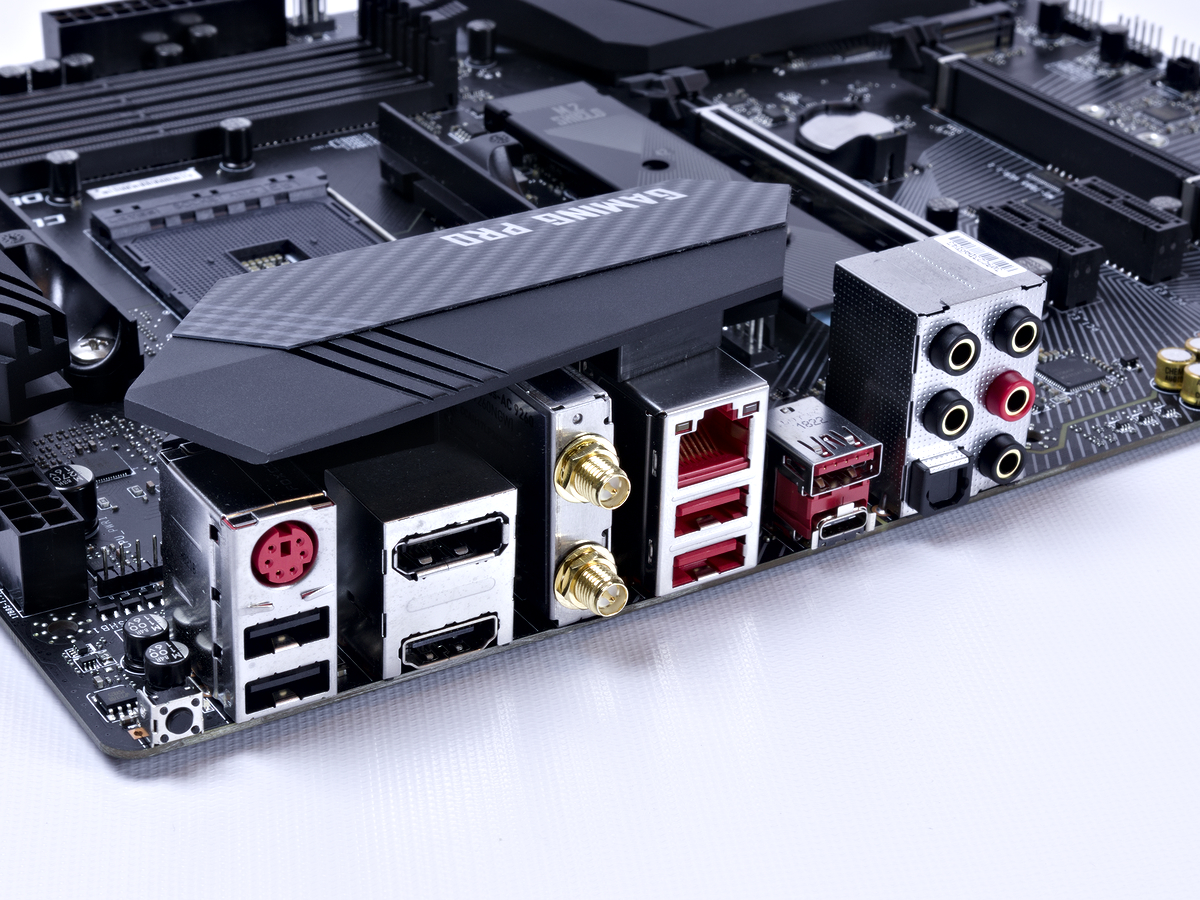

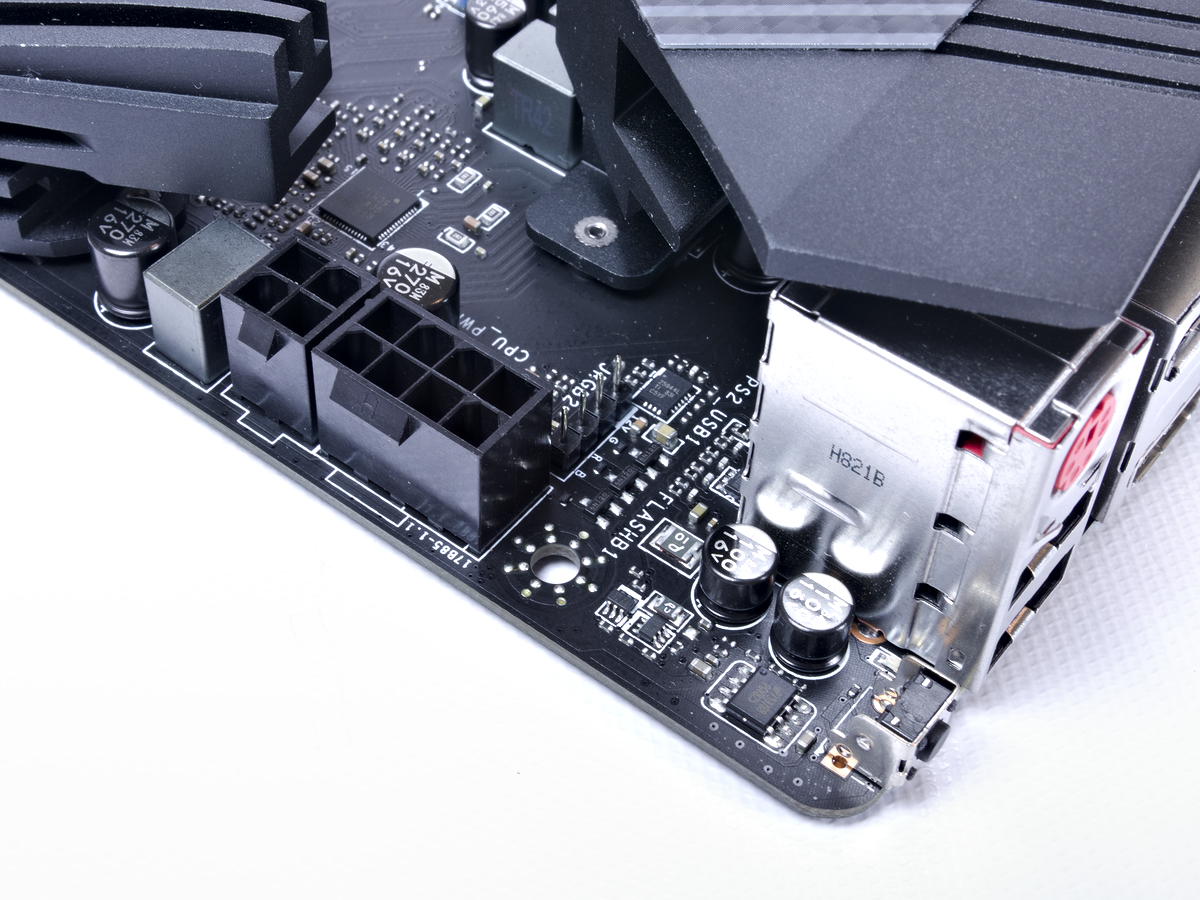
The MSI B450 Pro Carbon shares similar features to our previously reviewed Gigabyte B450 Aorus Pro Wifi, but sports a toned-down aesthetic and enhanced user experience. On the back panel, the MSI B450 is well rounded, with five gold-plated analog audio, one S/PDIF, two USB3.1 10Gbps (1 Type-A, 1 Type-C), two USB3.1 5Gbps, two USB2.0 ports, and one RJ-45 port connected to the Intel I211AT Gigabit Network controller. For builders who don't want or need a dedicated graphics card, HDMI and Display Port ports are available and support HDMI 1.4 and DisplayPort 1.3 bandwidth requirements. Wireless connectivity is provided through an Intel Wireless-AC 9260 add-in card with support for up to 802.11ac and Bluetooth 4.2. Extra ports for this board include a PS/2 port and a BIOS Flashback Button in case you need to recover or upgrade the UEFI on your board.
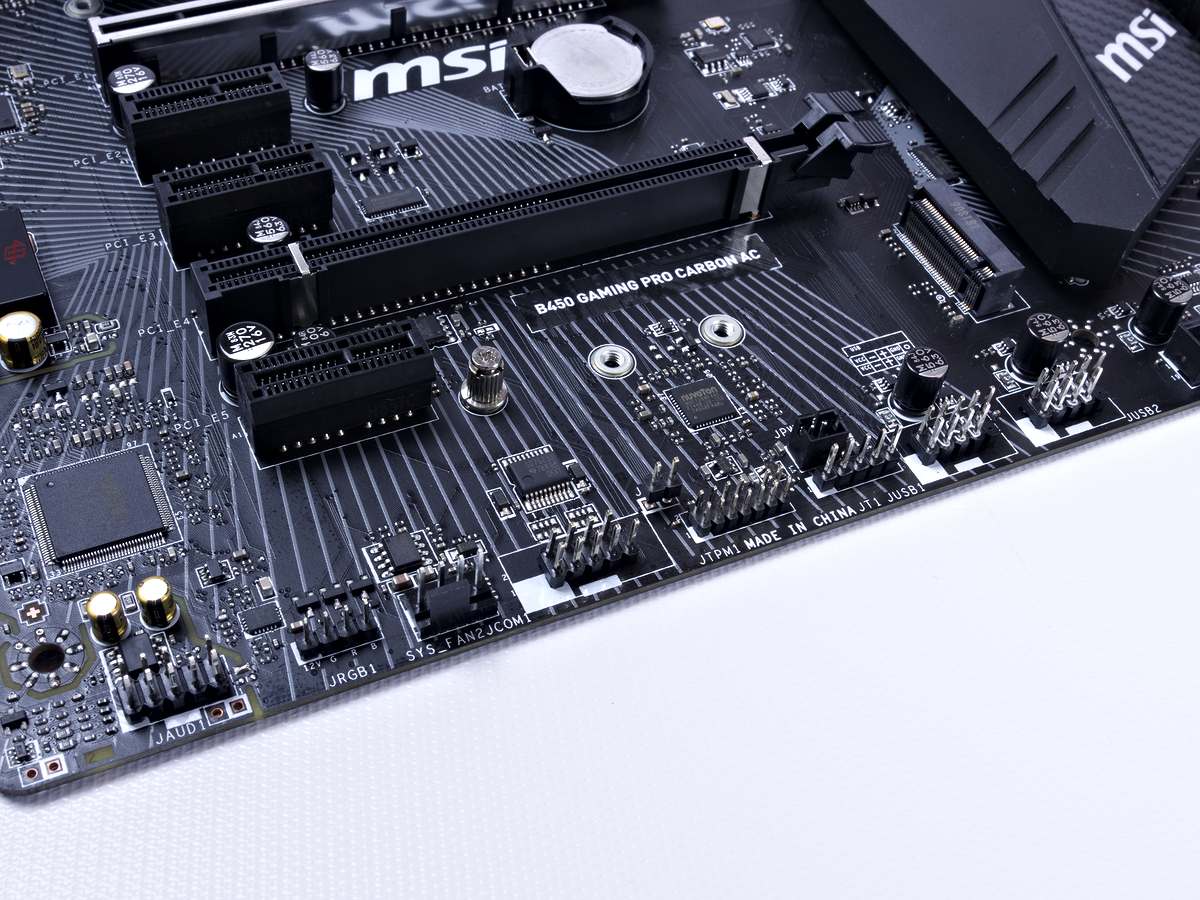
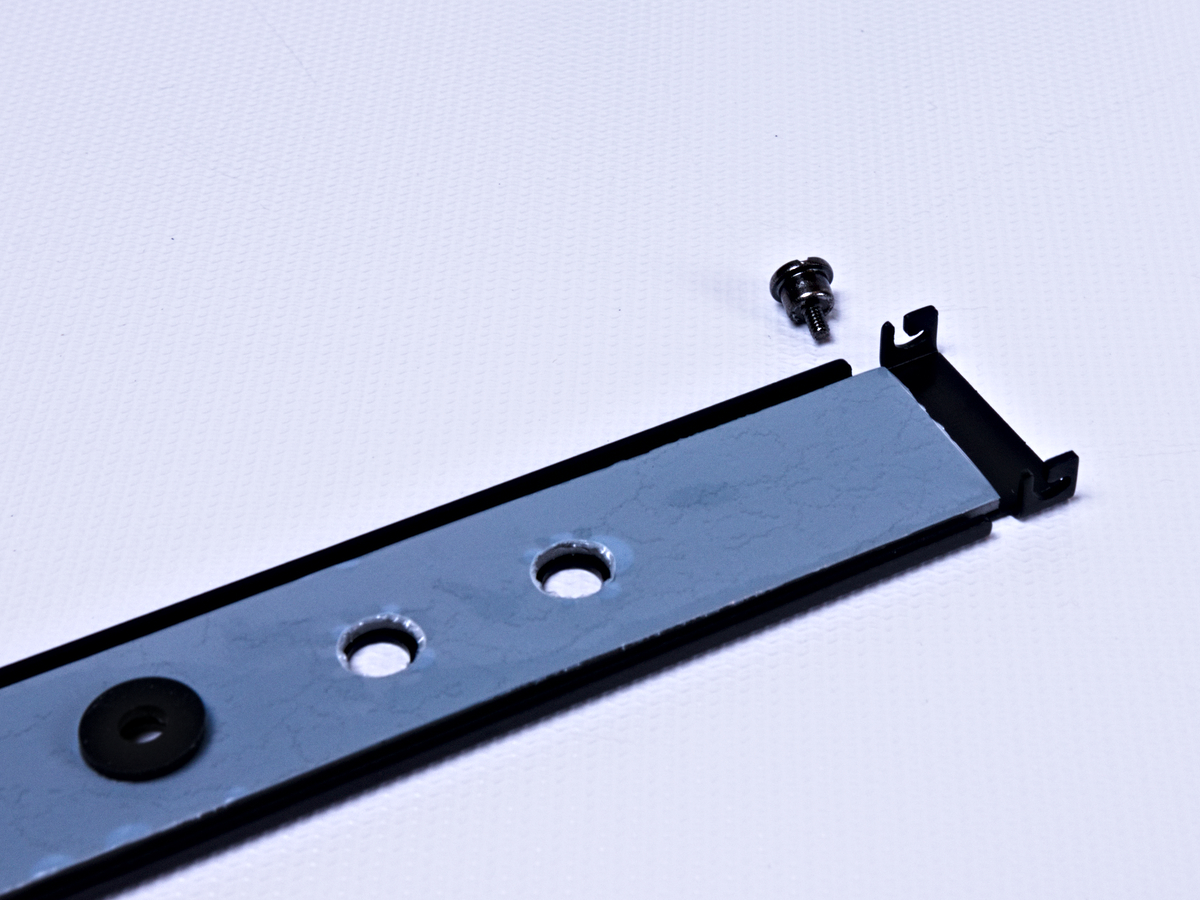
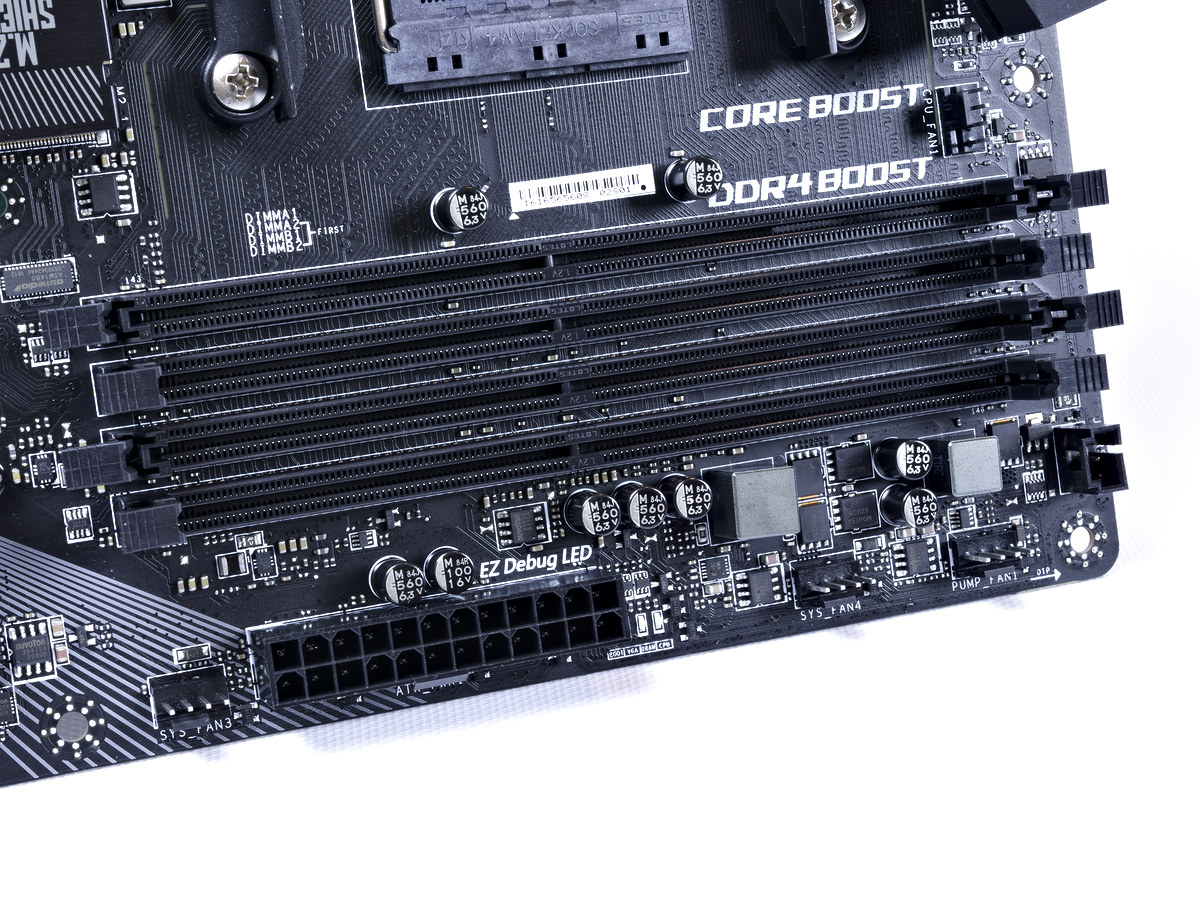
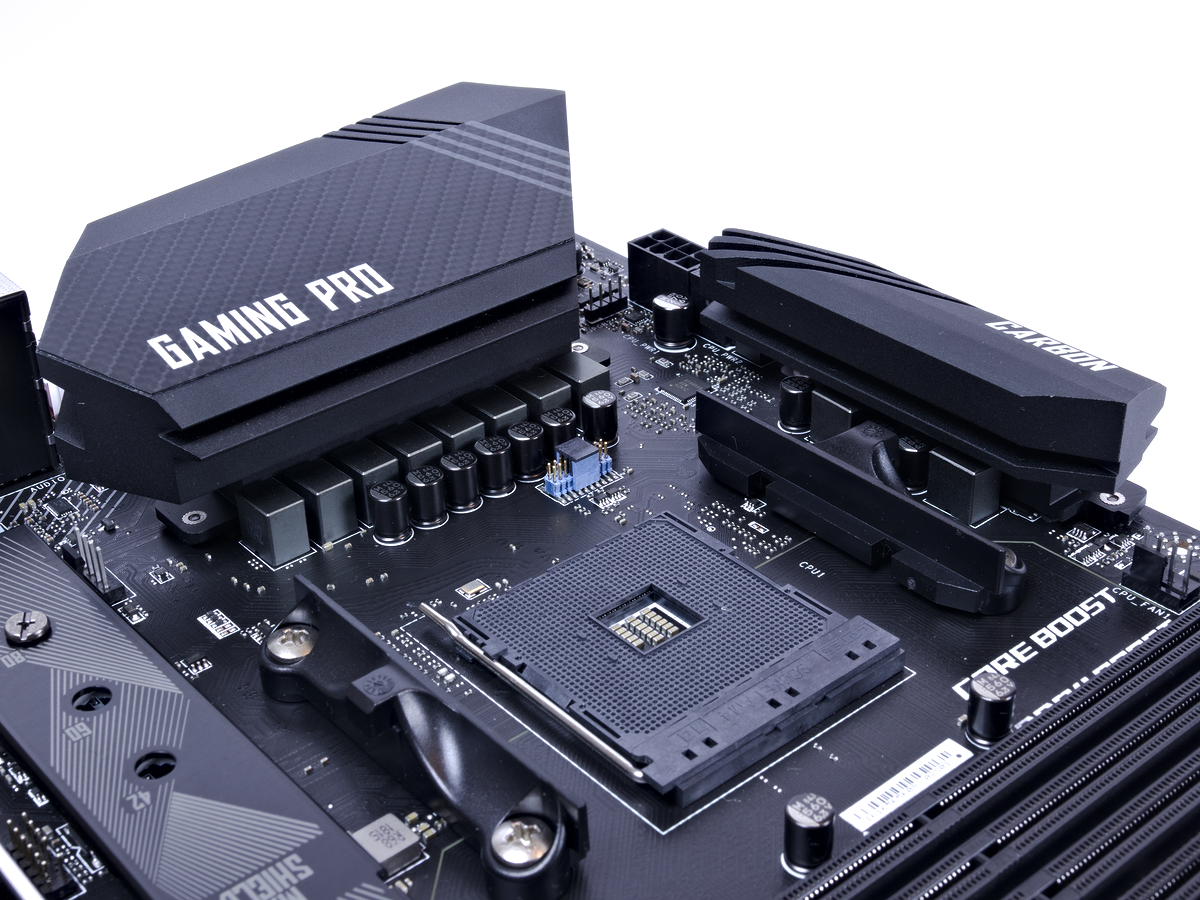
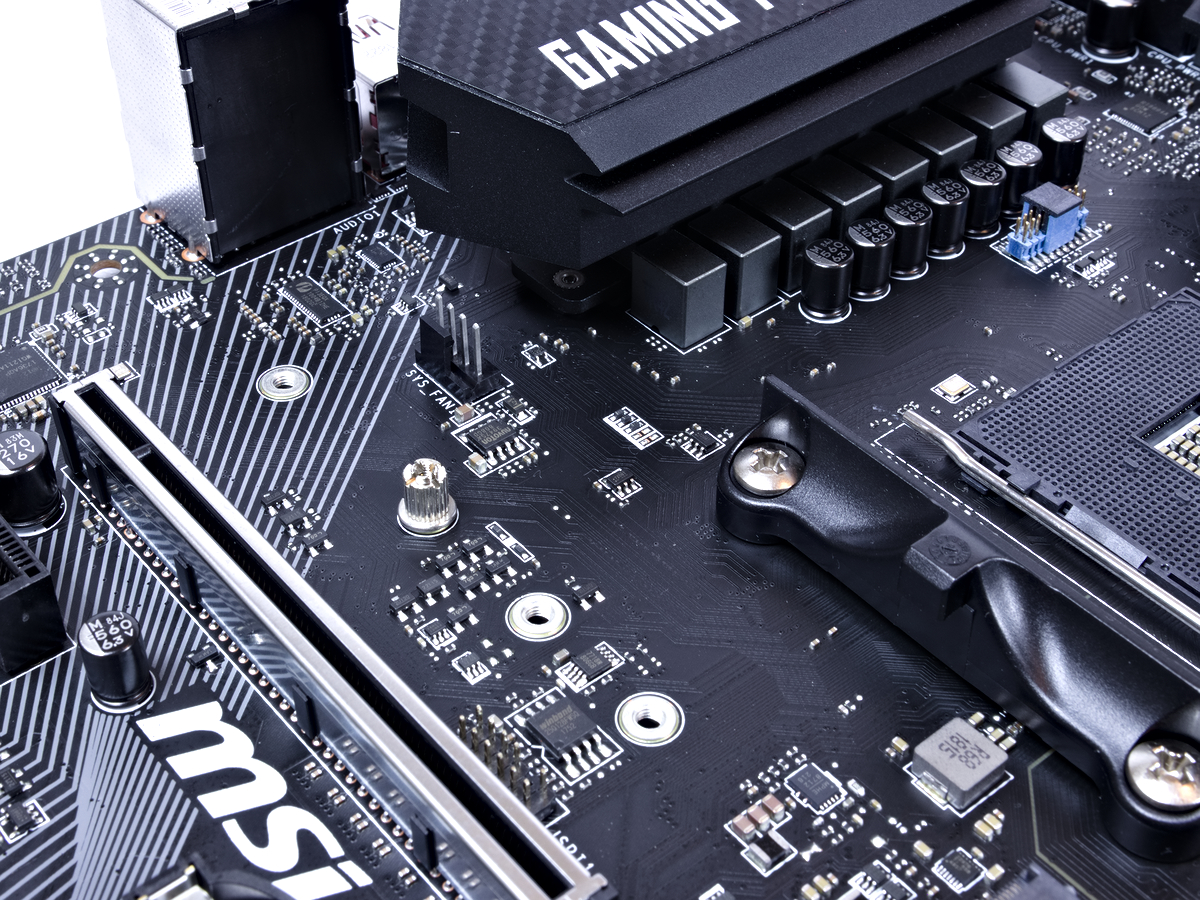
It’s nice to see a more streamlined aesthetic across the entire product with a flat-black PCB providing the backdrop for the carbon-fiber-textured heatsinks and M.2 shields. The Realtek AC-1220 powered audio circuitry isn't covered by fancy plastic coverings, which could have hindered expansion card installation. Rear IO connectors are interestingly covered with the VReg heatsink instead of a plastic shroud made infamous by Gigabyte and ASRock. The bottom edge of the board houses the pins for front-panel audio, one of six 4-pin fan headers, TPM, Serial COM, two USB 2.0 headers, one USB 3.0 5Gbps header, the front panel connectors, and both RGB and Rainbow LED headers. On the right side, we have six angled SATA 6Gb/s headers, three 4-pin fan headers, and the 24-pin ATX connector.
Topside, the Corsair LED, CPU 4-pin fan, and 4 and 8-pin EPS power connectors have a decent amount of spacing for cable management. Stuck in below the primary VReg heatsink is the final 4-pin fan header. Let us not forget to mention the dual-hinged DDR4 DIMM slots that are a step above a standard B450 bill of materials.
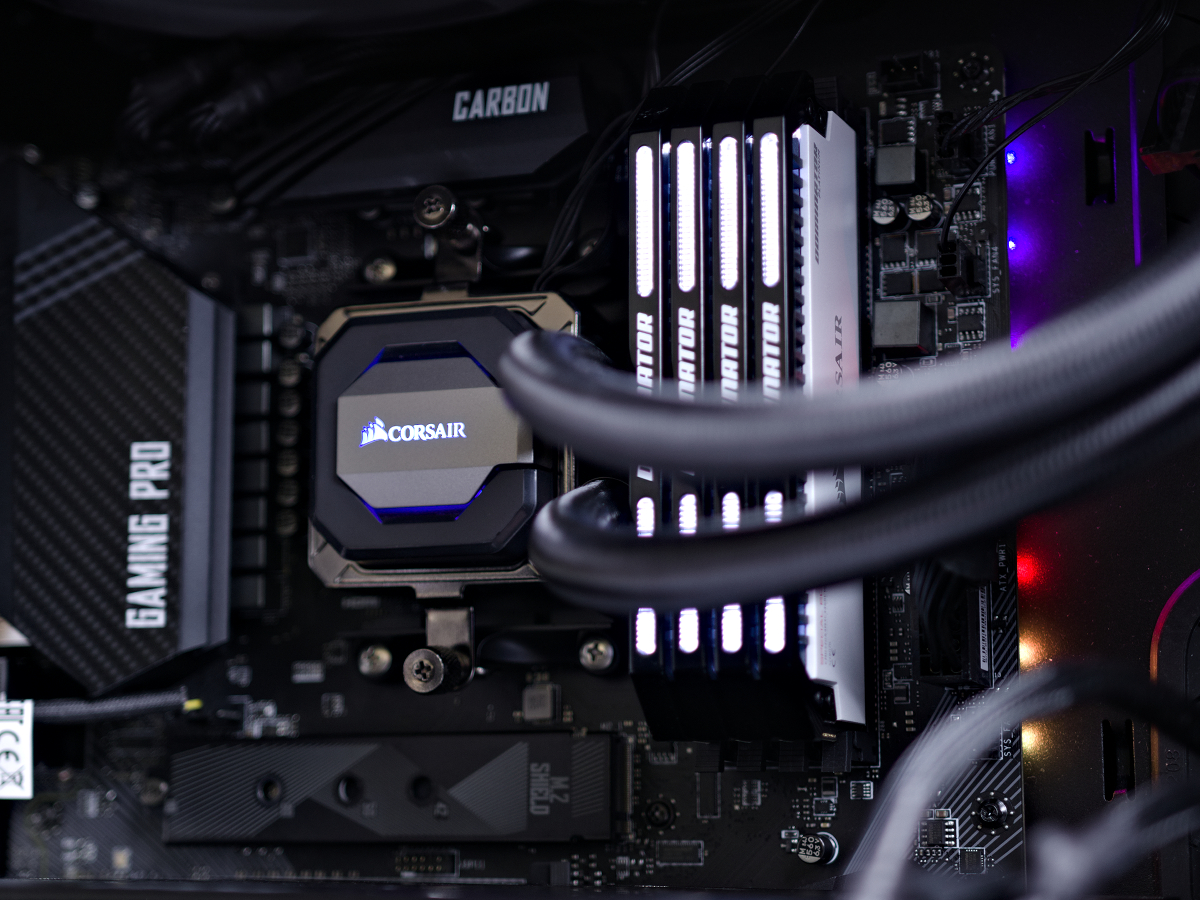
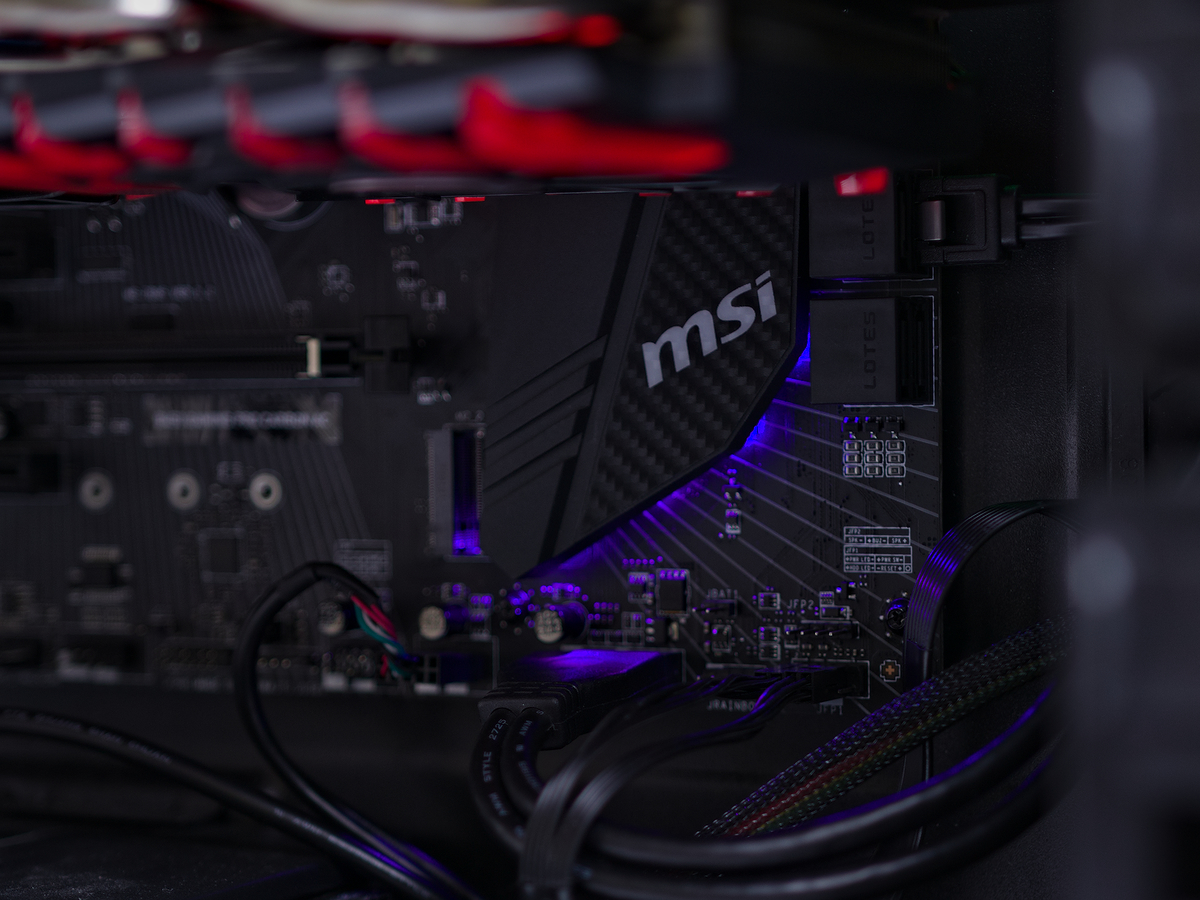
What good is a motherboard description without mentioning the RGB? Aesthetic illumination on this board is much-less vibrant than some of Gigabyte’s offerings. This MSI B450 Gaming Pro Carbon AC delivers an accented southbridge heatsink, and the top-right portion of the planar has LEDs on the backside that provide some background ambiance. For additional lighting, there are four ports on the board for plugging in various lighting solutions which are spread out in convenient locations around the board. Be cautious though, mixing 12V and 5V lights could damage the attached equipment, so consult all manuals before incorrectly RGBing yourself. All these lighting effects can be controlled through the MSI Mystic Light Sync software and the UEFI to program desired lighting effects.
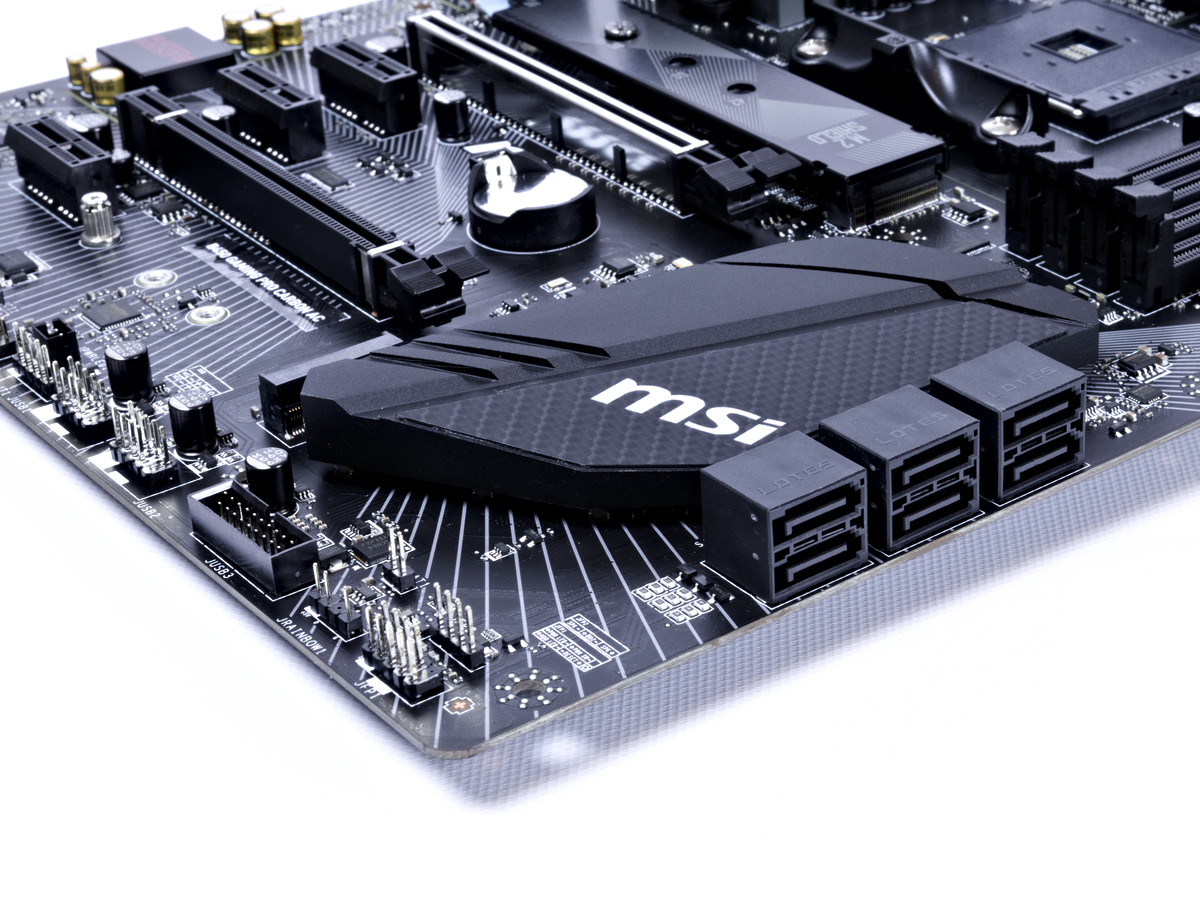
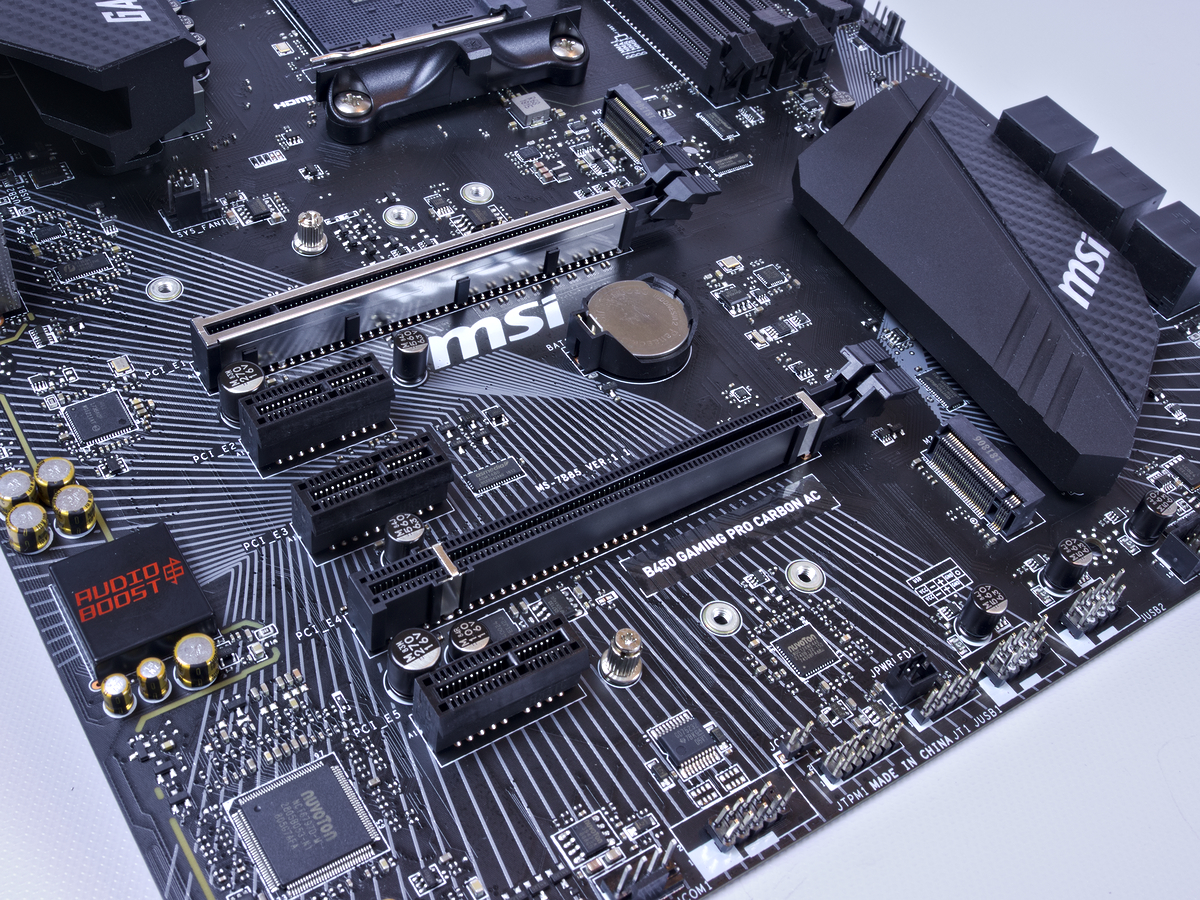
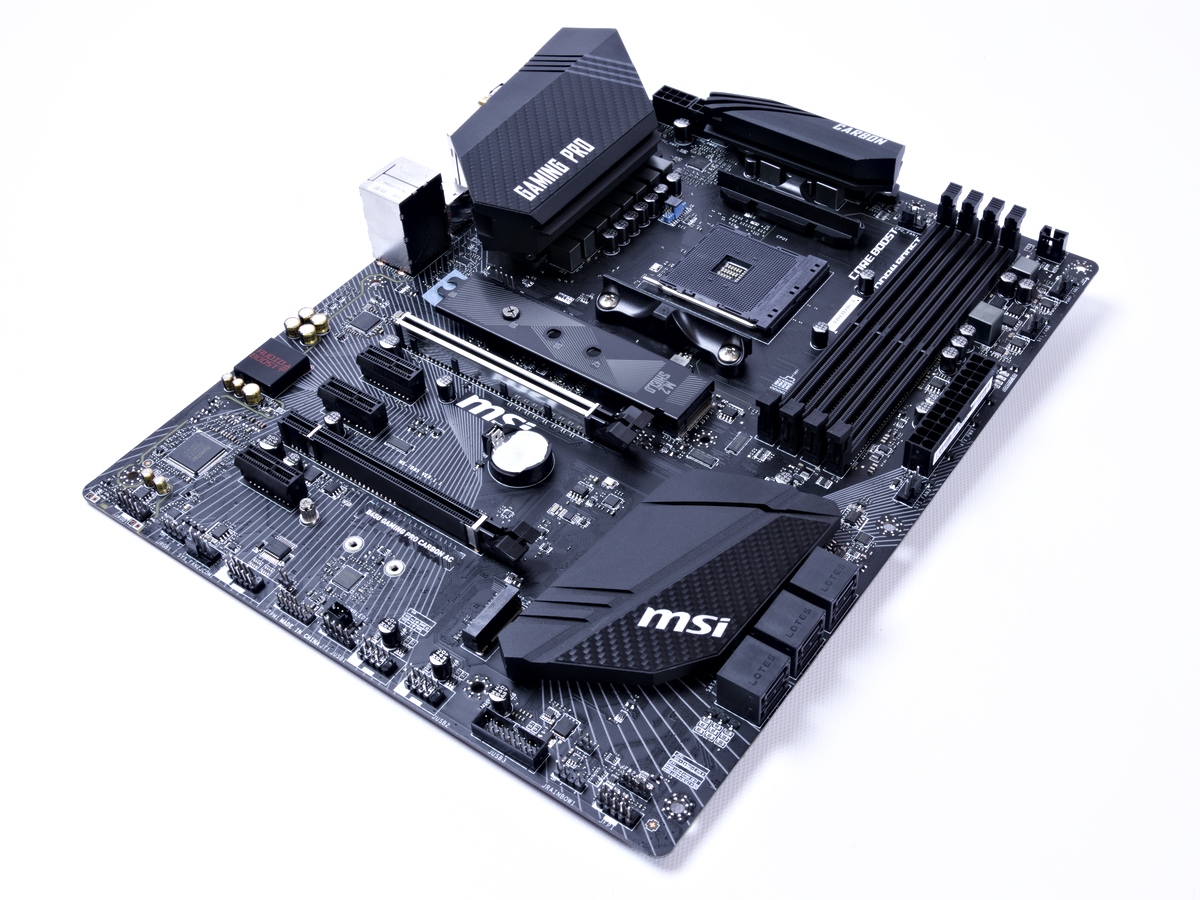
Let’s dig into the PCIe and storage options on this board. As it would appear, we have room for two x16 cards and three x1 slots at our disposal, along with two M.2 slots and six SATA3 ports. However, glancing at the spec sheet, we see a lot of asterisks. On the NVMe front, the top slot is wired up for PCIe Gen3 x4, the classical NVMe wiring, while the bottom slot is wired out for PCIe Gen2 x2, or half the available bandwidth of most NVMe slots. The 2nd M.2 slot only supports PCIe types of drives, and populating it denies access to all the Gen2 PCIe slots. If using the primary M.2 slot, two of the SATA ports are disabled, which is less than ideal.
Taking a step back from M.2, the PCIe wiring is less complicated, with the top slot providing 16 lanes of PCIe Gen3 and the next x16 slot wired out for four lanes of Gen2. B450 doesn’t support SLI, so this shouldn’t pose too large of an issue in most builds. Our recommended loadout for this board would be a GPU in the top slot, followed by a capture card in the last slot and using that top NVMe slot and up to 4 SATA devices in your builds. If more IO is needed, step up to X470 or go wild (and maybe broke) with X399.
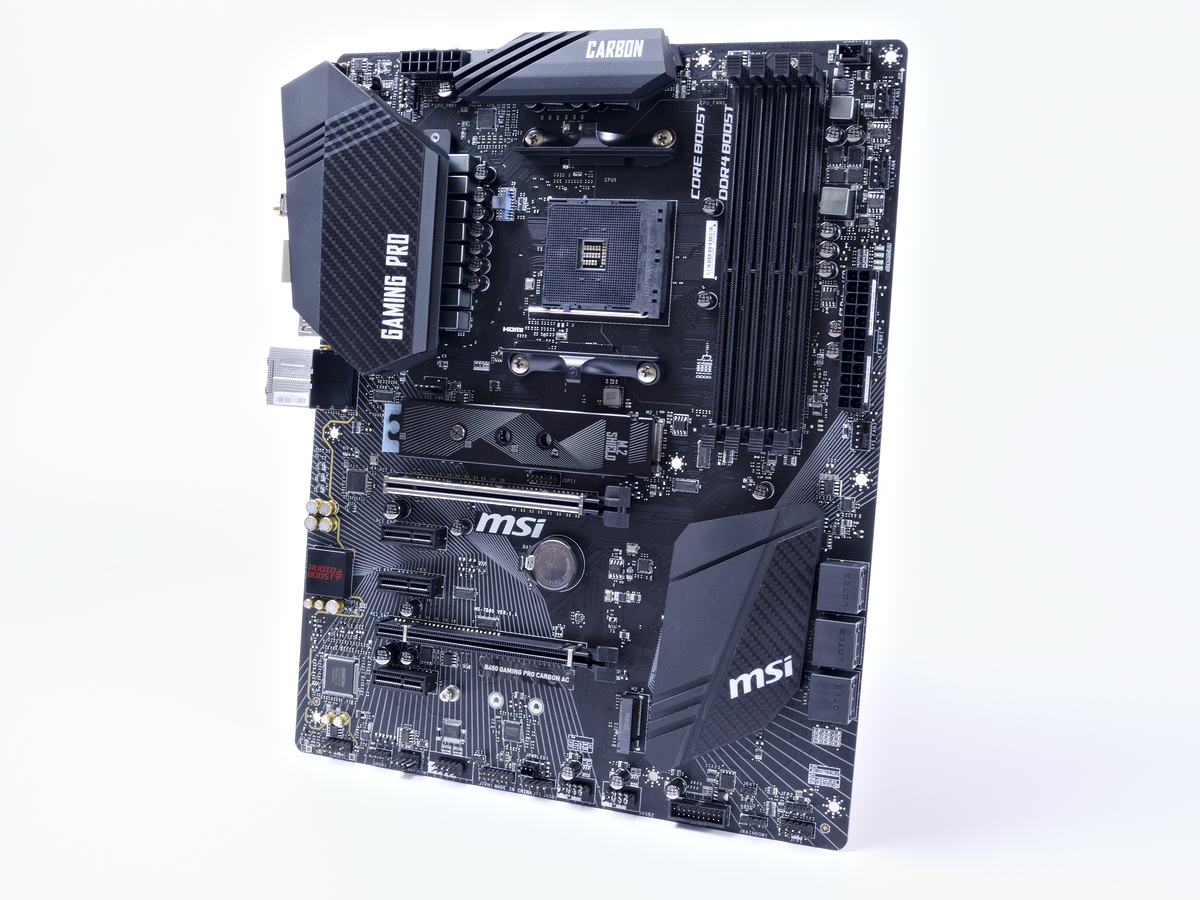
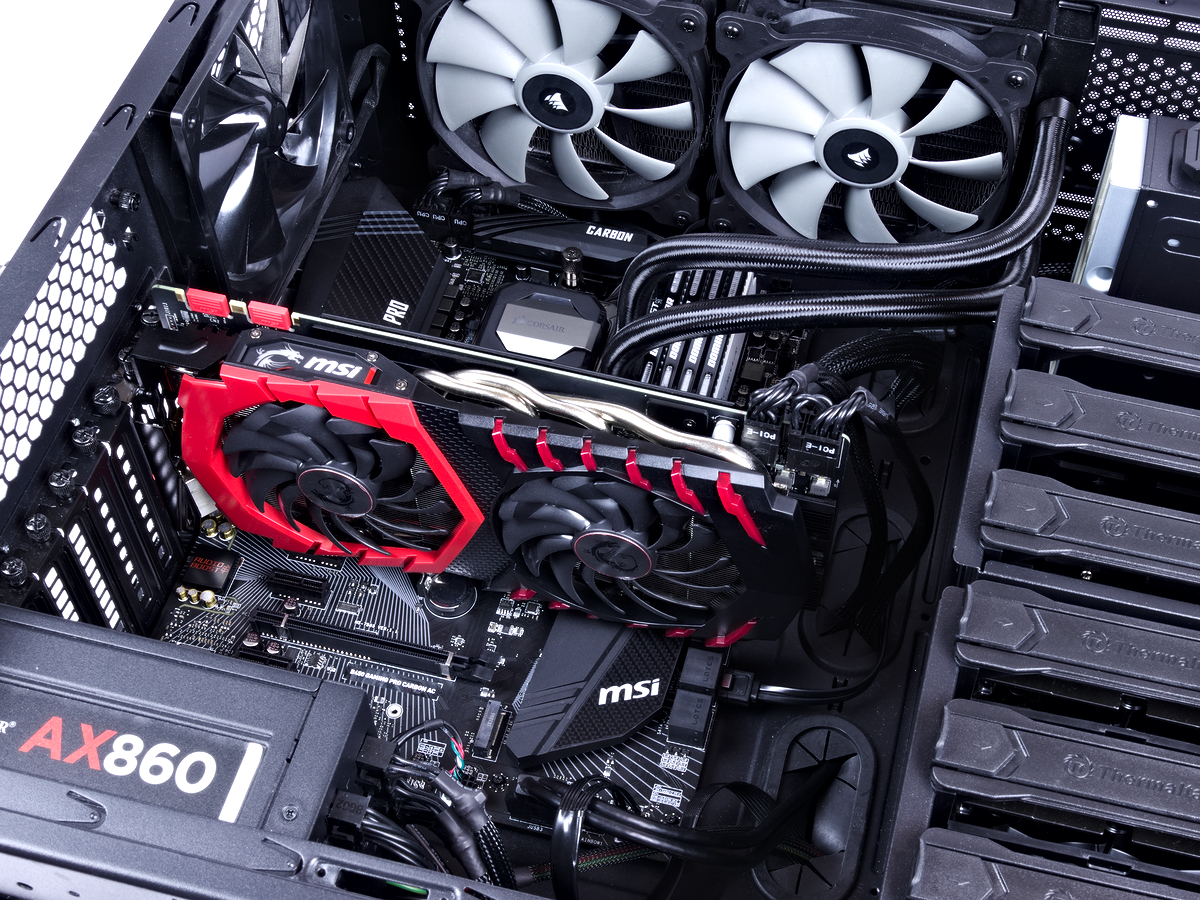
This board gets a lot right from an aesthetic and feature set perspective, but the PCIe and NVMe scenario could have been delivered better. It would have been nice (and simpler) if MSI had just removed the 2nd M.2 slot and added some extra spacing for larger GPU coolers like the RX 590 Fat Boys out there. Also, maybe diverting PCIe slots from other components could have enabled all 6 SATA ports for full-time operation. Similar load outs can be found in the MSI B450 Gaming Plus, but on that board you lose the high-end luxuries of WiFi, beefier VReg circuits, and cleaner aesthetics.
UEFI
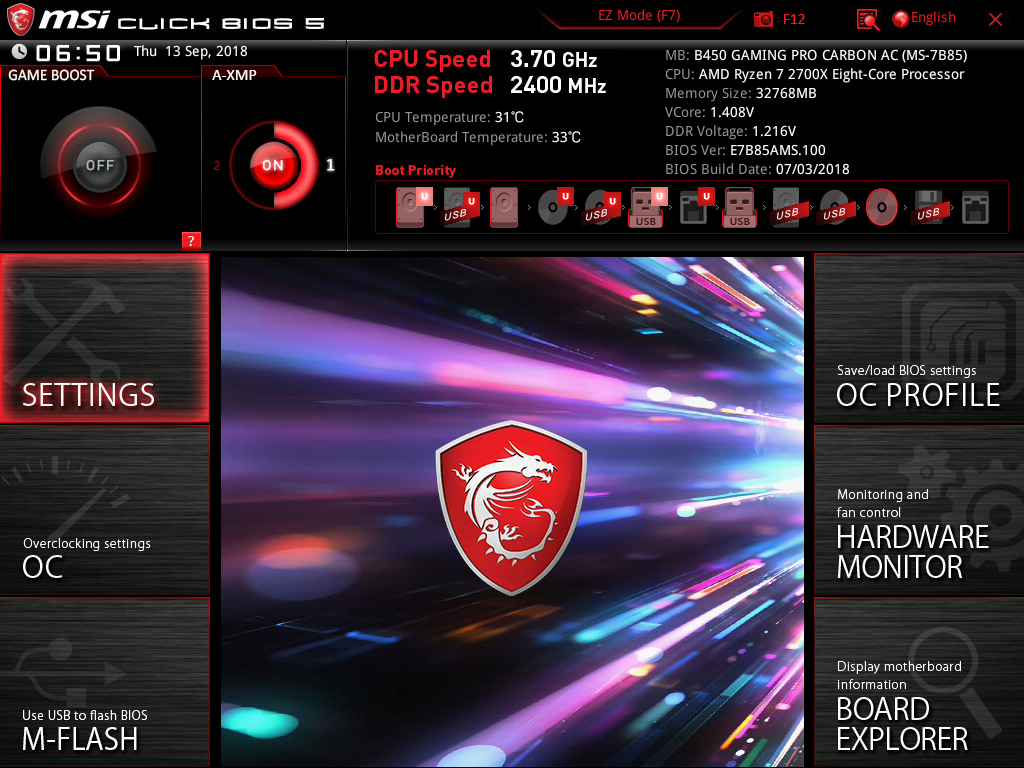

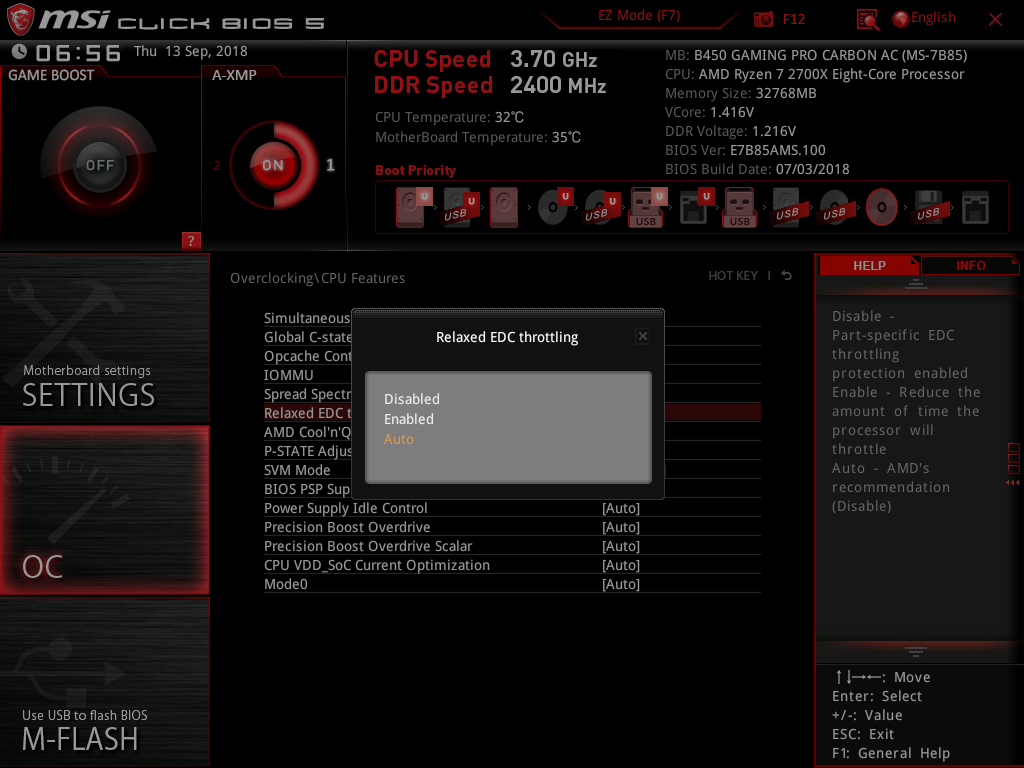
We have recently talked about the latest MSI UEFIs in our M7 Line: Refined Excellence review, so we won't rehash the full details here. But as for the MSI B450 Gaming Pro Carbon AC, we’re greeted to the well-polished Advanced Main Menu and can easily swap over to EZ mode, which has far less tweaker appeal. Game Boost is still available through firmware (since there is no physical knob), though the wealth of options located under the hood make manual adjustment the better alternative.
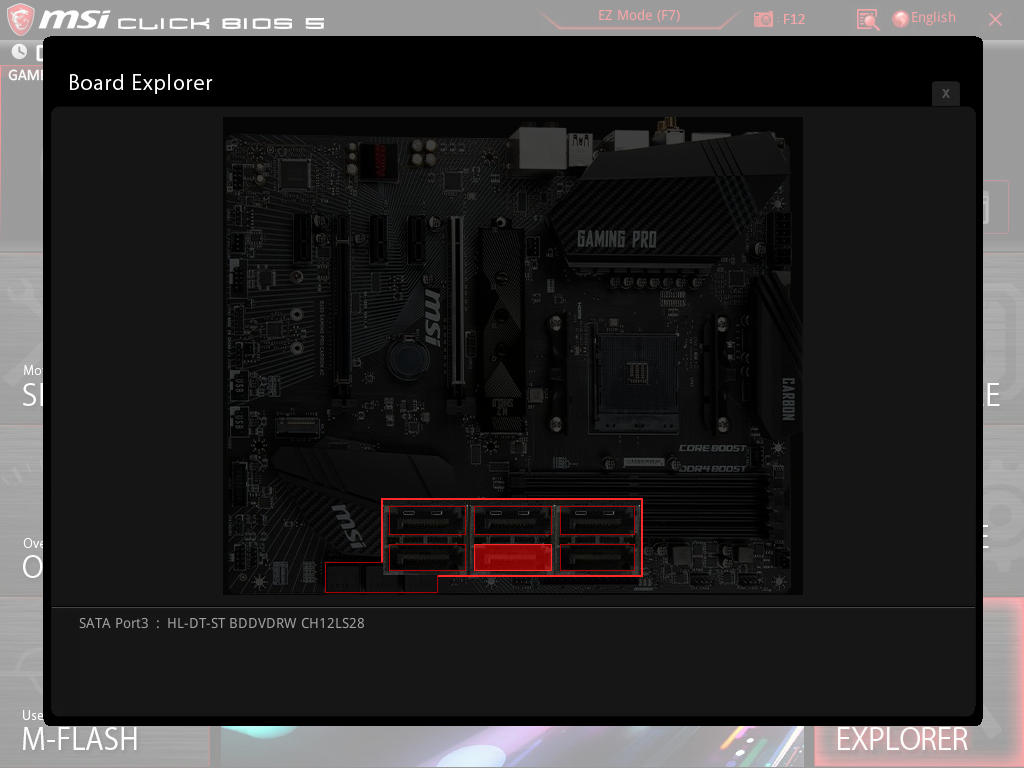
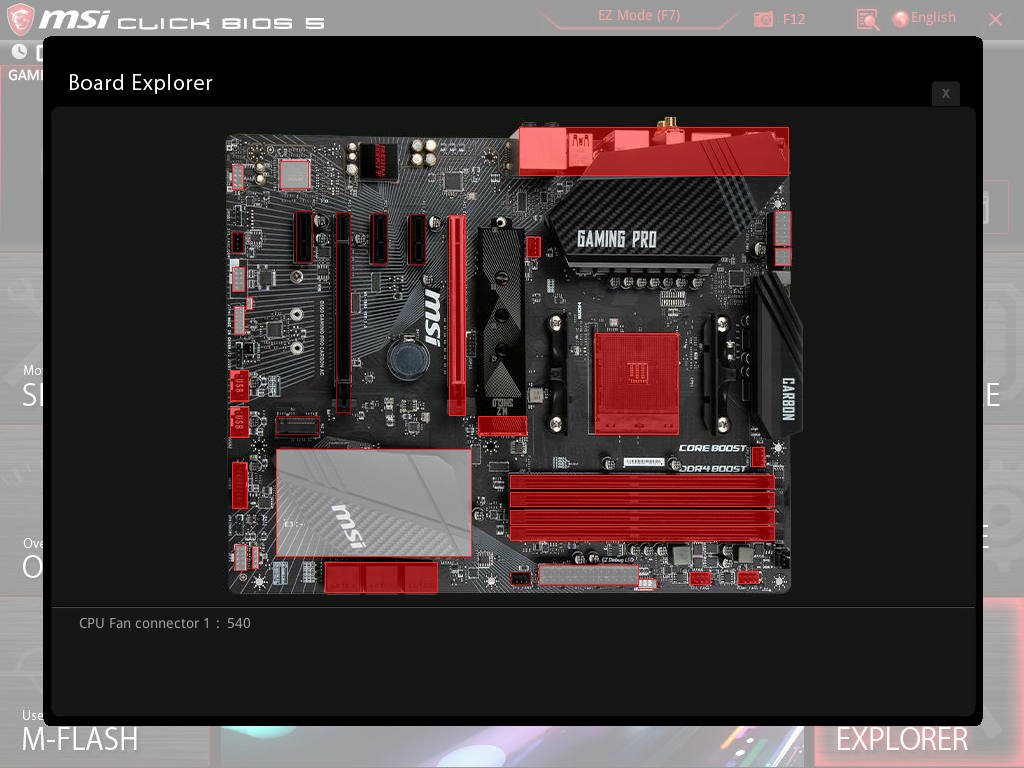
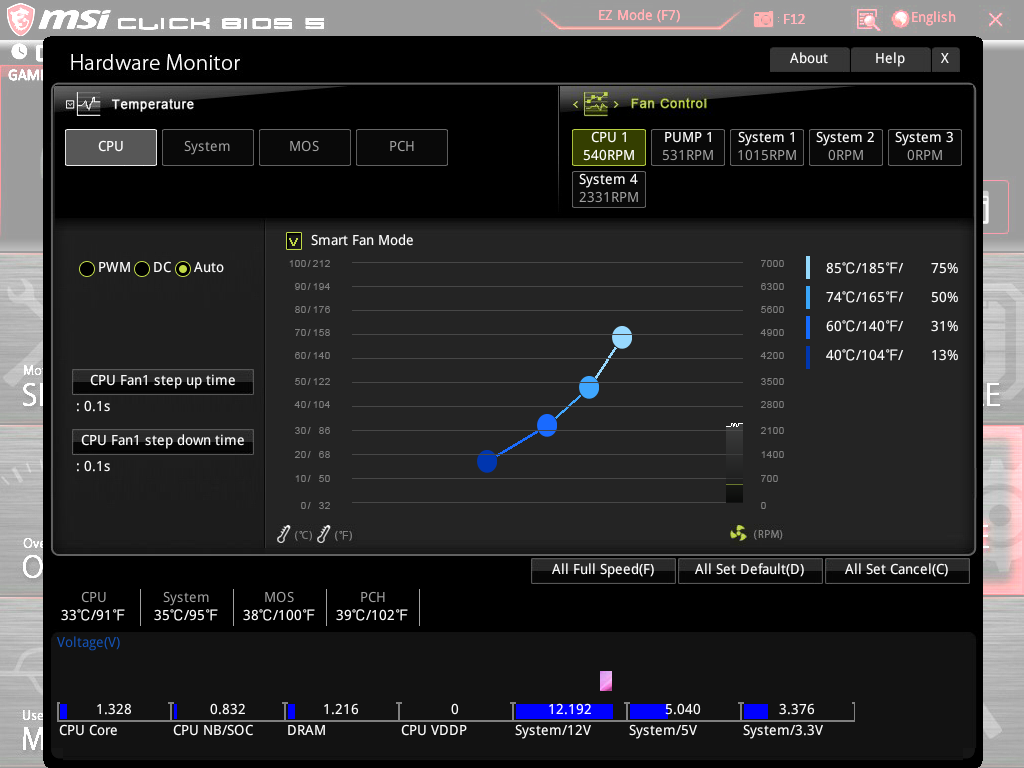
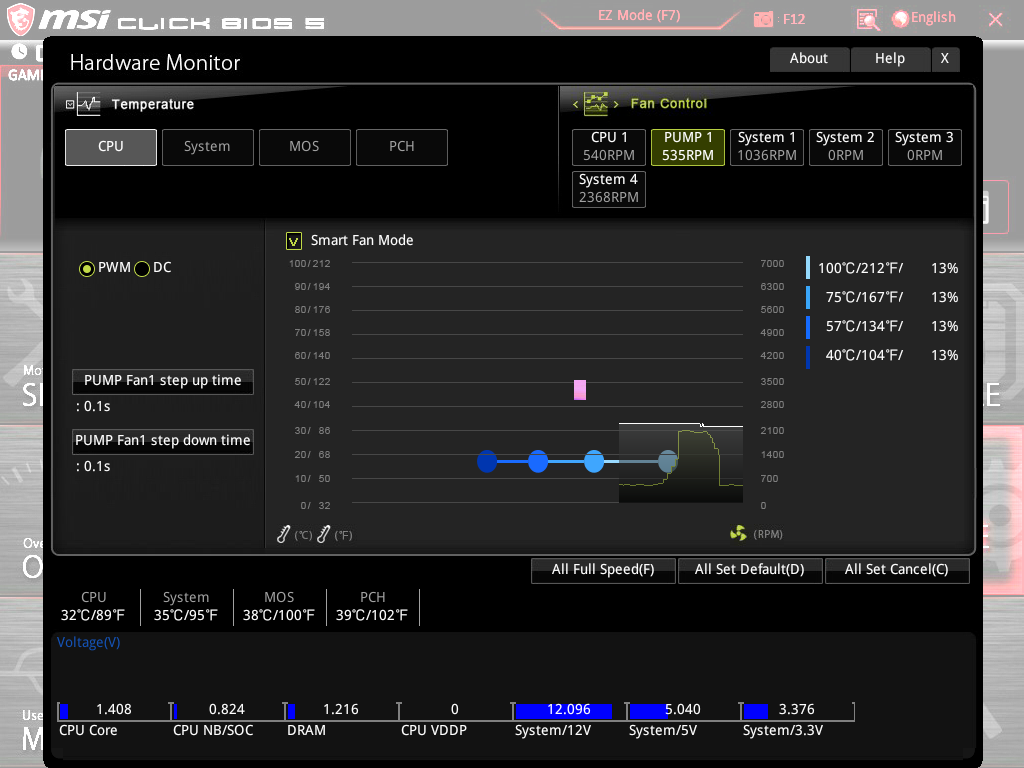
Diving into the board explorer, we see similar output as our M7 review and can easily check if our fans or storage disks are detected. The Hardware Monitor menu shows general purpose stats for the system, such as VCore voltage, DRAM voltage, and temperature readings for CPU, System, MOSFETs, and the PCH. The graph in the middle uses a color gradient system to help visualize the ramp in fan curves depending on the temperatures and fan speeds desired.
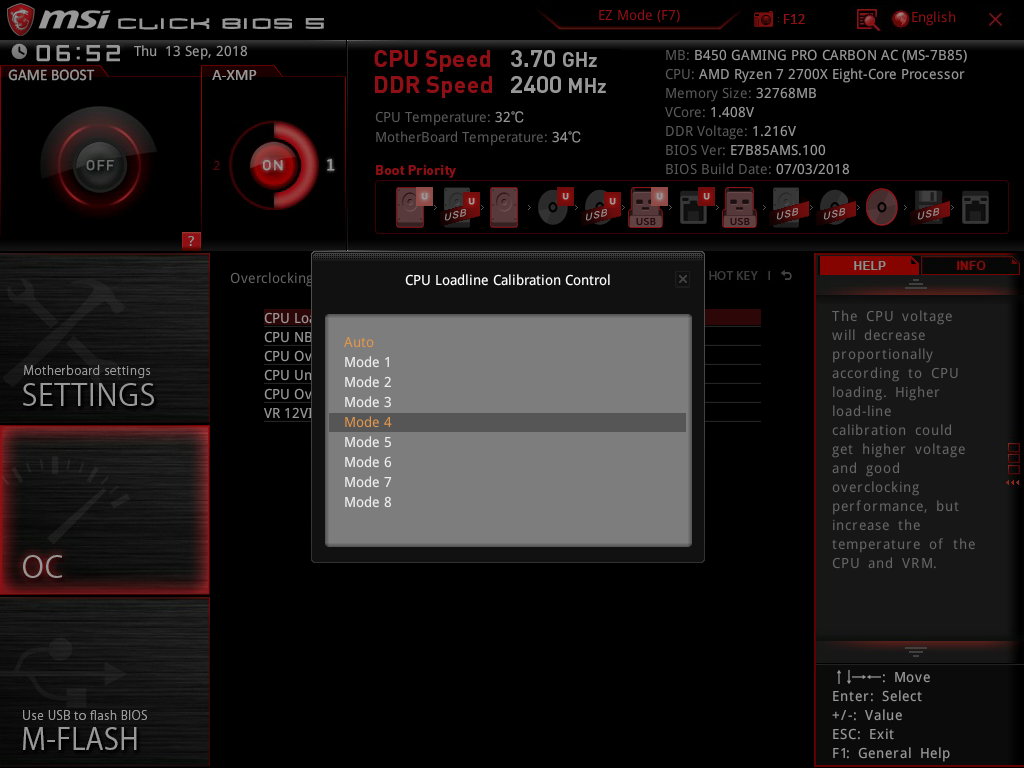
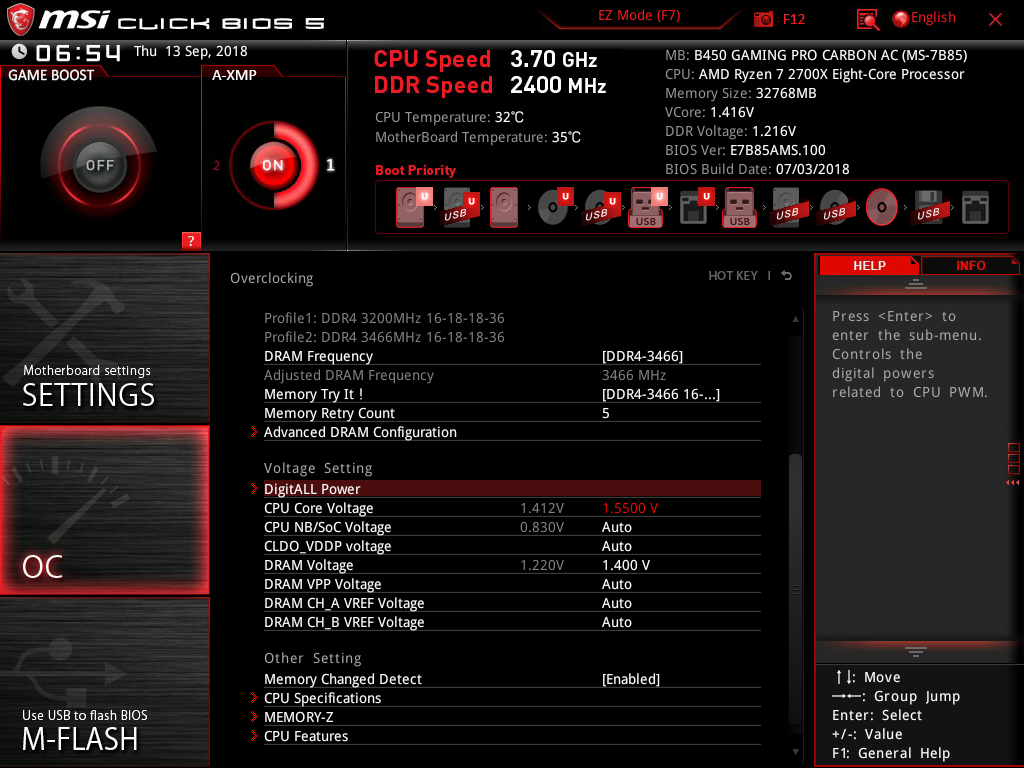
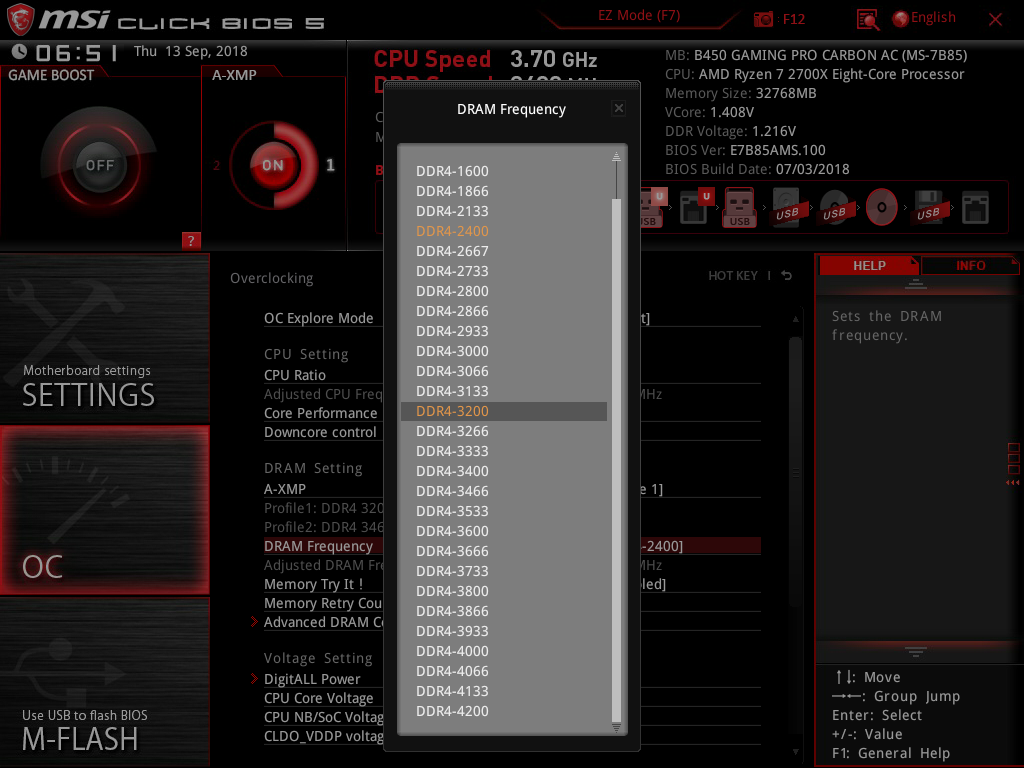
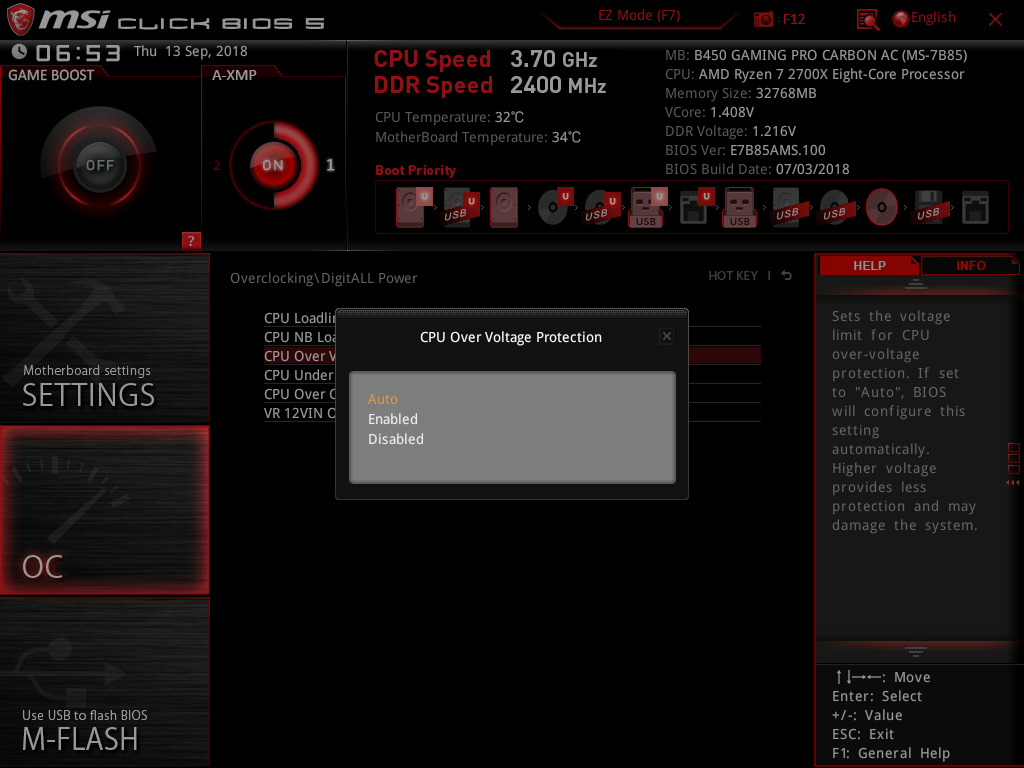
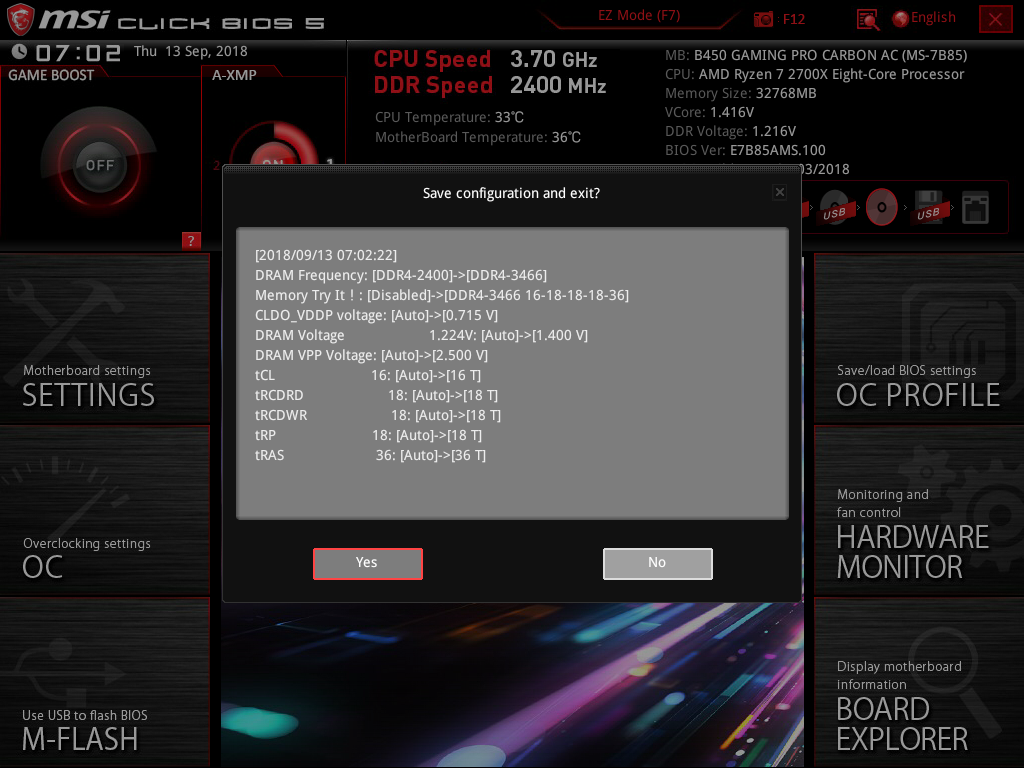
Since this is a higher-end mid-tier board, we decided to crank up some overclocking options. CPU Loadline Calibration has options from Mode 1 through Mode 8 (higher to lower load line settings respectively). CPU Core voltages are settable all the way up to an impressive 1.55V--which we would not recommend. Also, VCore voltages have a 12.5mV increment in case you want to adjust voltage manually. DRAM frequencies are selectable from a paltry DDR4-1600, up to an astounding DDR4-4200. And just in case you wanted to make sure you don’t blow things up, the VRegs on this board allow for some levels of over-voltage and over-current protection, which is a nice differentiator in the B450 landscape.
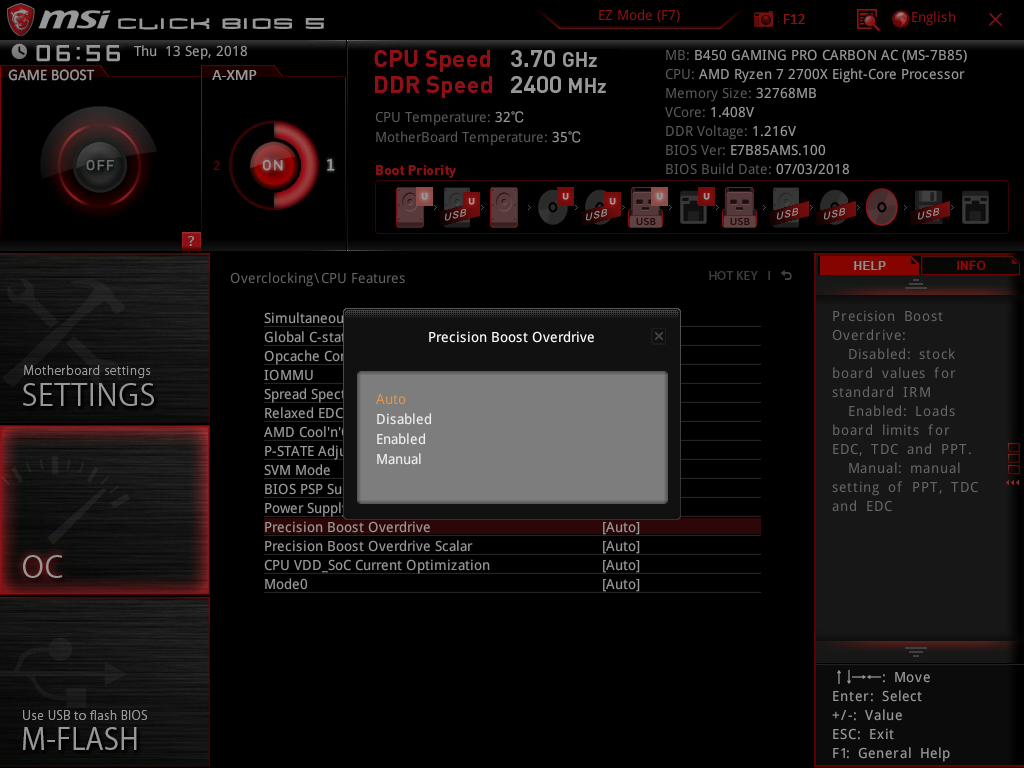
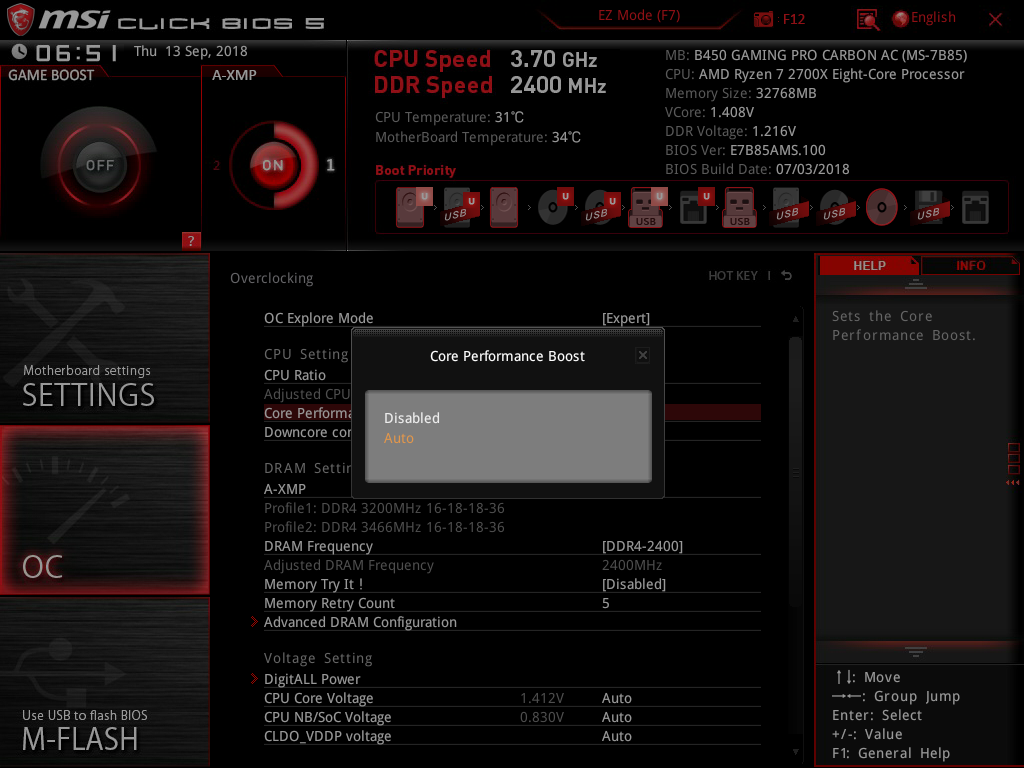
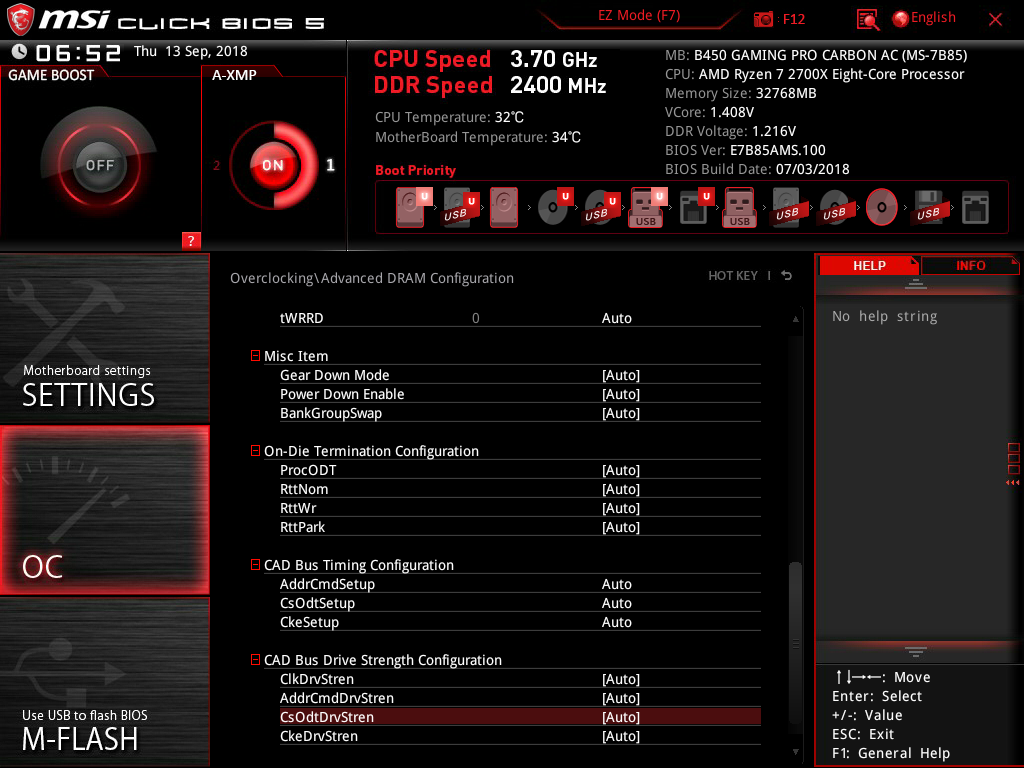
With 2000 series Ryzen processors, Precision Boost Overdrive is available for behind-the-scenes hardware-controlled overclocking, from which we have seen decent short-term performance increases. Also, the Core Performance Boost option is available and set to “auto” by default in our UEFI testing.
MORE: Best Motherboards
MORE: How To Choose A Motherboard
MORE: All Motherboard Content